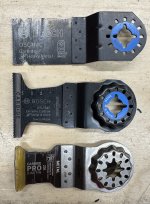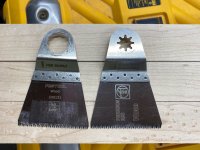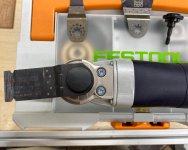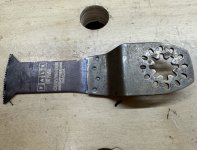rst said:
I’m pretty sure a Canadian guy came up with the curved blade idea. When he or whoever started, they offered a couple free at a small fee for trial and feedback. I got a couple of the first ones and now use the ones Bosch offers. They are great for glaziers removing wood or putty stops. I used one last week on an pod Anderson where the glass was as built into the frame assembly and glued.
You’re right, but it was two guys in Canada. After 4 years in development they started posting about their creation on Reddit,
nine years ago. What they came up with is a curved front bi-metal blade. They
partnered with FEIN Canada for distribution.
“Our blade performs well on laminates compared to
straight fronted blades which have more significant hammering issues at the corners of the blade. If I remember right, the hard layer on kitchen countertops is often melamine. It resists the entry of the corners on straight fronted blades which results in a heavy bash mark on entry.
The center cutting nature of Falx's a curved front results in a much cleaner entry in laminates.”
“The blade differs most notably in that it has a curved tooth profile. This really helps with ergonomics - it doesn't hammer and bash when it's plunging into material.
The blade's teeth also go in opposite directions so that helps with ergonomics, as well as a cooler cut. The opposing teeth balance the cut so you're not dragged in one direction or another which wears on you over time, in my experience.
We also have some different tooth geometry - dual angle relief angles which allow it to perform well in both wood and while cutting through nails. Our tooth set is unique - it creates a strong tooth but also keeps the steel out of the way of ejecting chips which has proved really important for a cool cut.
Lastly, the blade has a high-hardness low-friction PVD (physical vapour deposition) coating, like the big brother of TiN, which makes it more resistant to damage from nails, but also resists chips sticking which cause heat.
Don’t know what became of the company. Hope they made some money for their excellent idea.





